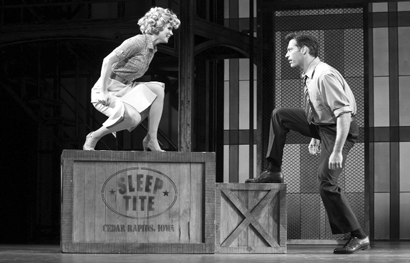Kelli O’Hara breathes wonderful life into classic1954 musical
Kathleen Marshall’s bold, bright and exuberant revival of “The Pajama Game” is the perfect antidote to the midwinter blues. This classic show from 1954 that generally inspires groans when people talk about it—conjuring as it does images of bad high school and summer stock productions—is much more likely to inspire awe in the energetic and carefree production. Don’t ask for anything but to be entertained and amused and you will be heartily rewarded.
Especially with the performance of Kelli O’Hara as Babe Williams. O’Hara—who was equally brilliant, though quite different, in “The Light in the Piazza”—gives a performance that is centered, confident, sexy, high spirited, and absolutely delightful from beginning to end. Moreover, she is such a talented singer and brilliant technician that it’s possible to surrender oneself completely to her and enjoy every dazzling moment when she is onstage.
Of all the leading ladies of contemporary Broadway, only Faith Prince—where has she been?—comes close in terms of technique, command of a role, and a presence that is just plain irresistible. O’Hara takes what is generally a shallow character and imbues her with such sass and substance that it’s possible to overlook the weakness of the book.
Speaking of which, for all those who decry the rise of the “jukebox musical,” a collection of songs around which a book has been written, it should be pointed out that “The Pajama Game” is probably the original jukebox musical. The only difference is that when it was written, Broadway was the source of popular music. The plot is a forgettable story about workers in the Sleep Tite pajama factory, their demand for a seven-and-a-half-cent raise, and the love story between the new superintendent, Sid Sorokin, and grievance committee chairwoman, Babe. The songs, however, are classics of the American Songbook—“A New Town is a Blue Town,” “Steam Heat,” “Hey There,” “There Once Was a Man,” and “Hernando’s Hideaway.” The songs are so delicious, the fact that they have been shoehorned into the plot makes not a bit of difference to the enjoyment of the evening.
Harry Connick, Jr. is making his Broadway debut as Sid. Of course he can sing; he’s got a phenomenal voice and performs his songs with his trademark suavity. “Hey There,” a duet with the Dictaphone, is charming. And “Hernando’s Hideaway” is a rare moment of musical theater that borders on the historic. The problem with Connick, though, is that—unlike O’Hara, who connects so openly with the audience and the other actors—Connick’s beautiful renditions of the songs seem unmoored from the rest of the show. As a director, Kathleen Marshall really should have brought him back to the world of the show—not allowed him to be alone in a world of his own.
Nonetheless, there are still abundant pleasures to be had. Marshall’s choreography is generally understated and appropriate, particularly in “Steam Heat,” which is an homage to Bob Fosse, the original choreographer. The sets by Derek McLane are spectacular, and the costumes by Martin Pakledinaz are terrific—particularly the deliriously colorful pajamas.
In addition to O’Hara and Connick, the company absolutely sparkles. Michael McKean is great as the time-study man, Hines. Peter Benson as the nerdy Prez has all the comic abandon one would expect from this kind of material. Joyce Chittick as Mae delivers “Steam Heat”—along with Michael Halling and Vince Pesce—with a pixie-like charm that underscores the sexuality of the number. Megan Lawrence is outrageously funny as Gladys, the repressed secretary who finds a couple of drinks really loosen her up.
All of these are, of course, stock characters designed to provoke predictable laughs in predictable situations—but there is something comforting in the familiarity of it all. And, to her credit, Marshall has managed to create an integrated world out of all of this. One actually believes that there was a time when labor and management could talk to one another without shouting and being demeaning. But, then, this is fiction from a time long, long ago.
For my money, if you have to choose, the musical revival to see is still “Sweeney Todd,” but that’s certainly not to all tastes. “The Pajama Game” has something for everyone and delivers it in this wholly engaging production. It’s perfectly safe entertainment, and when you factor in Kelli O’Hara’s performance as well as Connick’s appeal, especially in “Hernando’s Hideaway,” it becomes something rare and longed for—a big, splashy Broadway hit.
gaycitynews.com


































